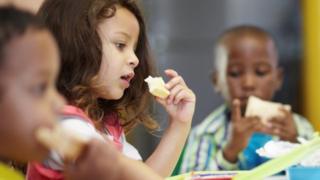Obesity inequality gap grows for Scottish children
Children in the poorest parts of the country face a bigger risk of being overweight or obese, new figures show. …

 Image copyright Getty Images
Image copyright Getty Images The obesity inequality gap among Scottish schoolchildren is continuing to grow, new figures show.
Almost a quarter of children in Scotland are starting school at risk of being overweight or obese.
The problem is worsening for pupils in the poorest areas, while children in affluent areas are much less likely to experience problems with their weight.
Scottish ministers say they are investing in a range of measures to try and halve child obesity by 2030.
The proportion of pupils entering education overweight has remained constant since the start of the century.
But, according to the Body Mass Statistics of Primary One children in Scotland report, “substantial inequalities” in child unhealthy weight exist across the country,
Cath Morrison, a public health programme manager for NHS Lothian, said: “We can see there remains significant inequalities when it comes to the risk of obesity and children who live in poverty compared to those who do not not.
“It is something we, as a society, and the authorities really have to act on.
“For families in this modern world it can be difficult to choose the healthier options, especially for ones involved in a day-to-day financial struggle.”
Problem worsening in poorer areas
Children in P1 were measured for weight and height and their body mass index (BMI) was then calculated and compared with growth data. They were then assigned to a healthy or unhealthy weight category and the unhealthy category was deemed “at risk”.
The data shows that in 2018/19, about three out of four P1 children had a healthy weight but 22% were at risk of overweight or obesity.
Of the 9,561 children measured in the most deprived areas in Scotland, 2,526 (26.5%) were judged to be at risk of being either overweight or obese, up from 26.1% in the previous year.
In the least deprived areas, 1,614 (17.5%) of 9,182 children were at risk of being overweight or obese, down from 17.1% in 2017/18.
Boys in P1 are also slightly less likely than girls to have a healthy weight, the study revealed.
Obesity in childhood is associated with a wide range of health problems such as risk factors for heart disease, type 2 diabetes, asthma, emotional distress and mental health difficulties.
A Scottish government spokesman said: “We are determined to improve Scotland’s diet and our ambition is to halve child obesity by 2030 and significantly reduce diet-related health inequalities.
“Wide-ranging action includes the introduction of a Restricting Foods Promotions Bill before the end of this parliamentary session to restrict junk food promotions that encourage impulse buying and over-consumption.”
What can be done to tackle Scotland’s childhood obesity problem?
Cath Morrison, a public health programme manager for NHS Lothian, shares her tips on helping children live a more active and healthy lifestyle:
- Don’t talk about being overweight or obese
Language can create a stigma which is harmful and hurtful, having a negative impact on our ability to make the right choices.
- It’s important not to create an environment of guilt or shame
Banning things can make individuals feel hurt or ashamed and you never make the right choices when you feel like that.
- Make healthier choices together as a family
It can’t be an individual approach when you’re trying to help children, it has to be a whole family approach to making changes.
- Physical activity doesn’t need to be traditional exercise
We get caught up in thinking that getting healthier is increasing physical activity but that can mean just putting on your favourite song and dancing around the kitchen. All of you together, having a bit of fun – and it doesn’t need to be outside.
- Look at how you reward children
It’s inevitable that we offer treats as rewards but often the greatest reward you can give your children is your time, whether it’s a story at bedtime or time together cooking in the kitchen.
- Be realistic about snacking
We all snack between meals and it might be easier to replace them by making a small swap, for example having a healthier snack in the morning and more of a treat in the evening.

